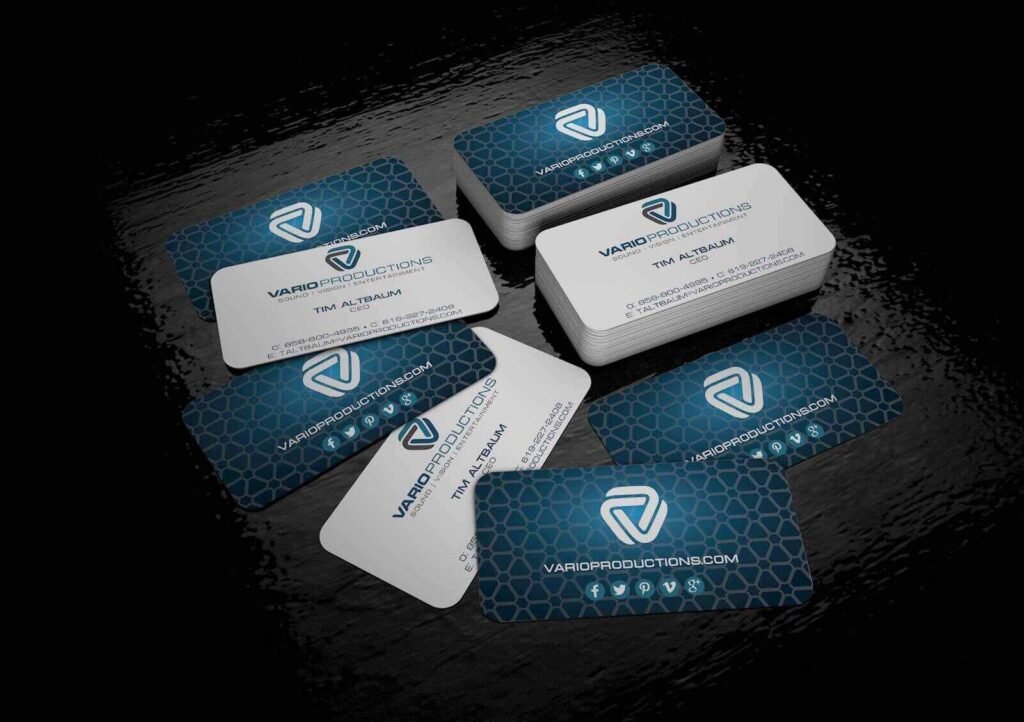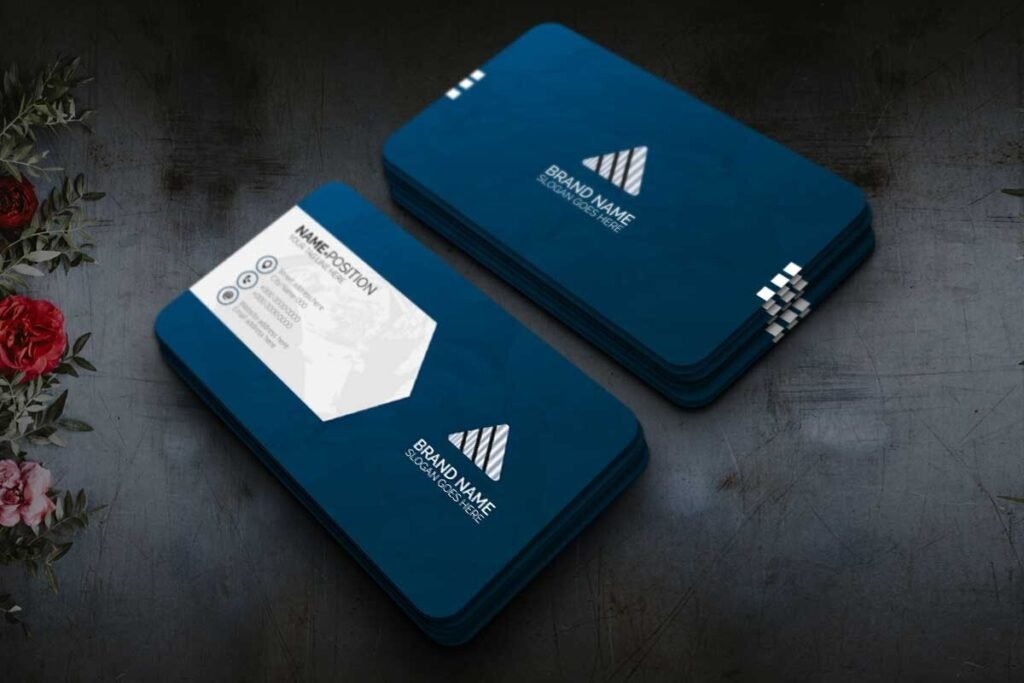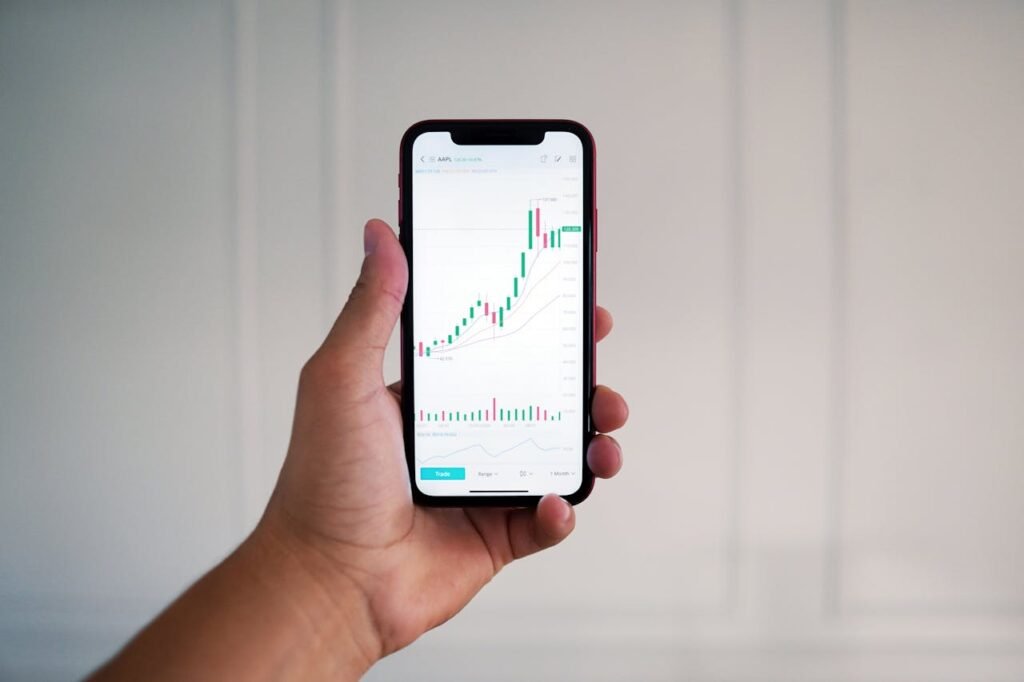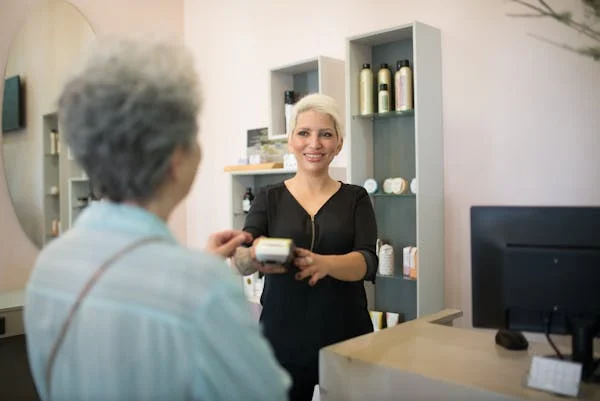In a world increasingly dominated by digital marketing, the humble business card remains a powerful tool. It’s tangible, personal, and can leave a lasting impression. But beyond the basics, there are innovative ways to use business cards to elevate your marketing strategy. Let’s explore how you can make the most of this small but mighty marketing asset.
Enhancing the Design and Functionality
Standout Designs
The first step in making your business card a powerful marketing tool is to ensure its design stands out. Think about incorporating unique shapes, vibrant colors, and high-quality materials.
A card that feels good in the hand and catches the eye can make a lasting impression. For example, using textured paper, metallic finishes, or die-cut shapes can add a touch of uniqueness.
Interactive Elements
Incorporate interactive elements into your business card to engage the recipient. This could be as simple as a QR code that leads to your website or a special offer.
Or, you might include augmented reality features that bring your card to life when scanned with a smartphone. These interactive elements can create a memorable experience and encourage further engagement.
Utilizing Business Cards for Networking
Crafting a Memorable First Impression
Networking events are bustling with opportunities to make connections, and your business card can play a pivotal role in making a memorable first impression. Ensure your card not only shares your contact information but also communicates your brand’s identity and values.
A business card with a unique design or a clever tagline can spark curiosity and make you stand out in a crowd. For example, a creative agency might use a visually striking design with a playful tagline like “Turning Ideas into Reality.”
Personalizing Your Approach
When handing out your business card, personalize the interaction to leave a lasting impact. Mention something specific from your conversation to show genuine interest and make your connection more meaningful.
For instance, if you discussed a particular challenge the person is facing, jot a quick note on your card about a solution or follow-up point. This personalized touch not only makes you more memorable but also sets the stage for a more substantial follow-up.
Strategic Card Placement
Strategically placing your business cards can significantly enhance your networking efforts. If you’re attending a conference or trade show, consider placing your cards in high-traffic areas like registration desks, lounges, or even partnering with event organizers to include your card in attendee welcome kits.
This not only increases your card’s visibility but also positions your brand as a key player in the event.
Leveraging Social Proof
Including a brief testimonial or a notable accolade on your business card can leverage social proof to your advantage.
For example, if your company received an award or a high-profile endorsement, mention it subtly on your card. This can build instant credibility and trust with new contacts, making them more likely to remember and engage with you.
Post-Event Follow-Up
The real power of business cards in networking lies in the follow-up. After an event, reach out to the people you met within a day or two. Reference your conversation and express your interest in staying connected.
This could be through an email, a LinkedIn message, or even a quick phone call. A timely and thoughtful follow-up can turn a brief meeting into a valuable relationship.
Creating Connection Opportunities
Think of your business card as a tool to create connection opportunities. If you’re hosting or speaking at an event, mention it on your card. This not only gives people a reason to keep your card but also encourages them to attend and engage with your brand further.
For instance, a business coach could include details of their next workshop on their card, inviting recipients to join and benefit from their expertise.
Demonstrating Value
Use your business card to demonstrate the value you can offer. This could be through a QR code that links to a free resource, a complimentary consultation, or a special offer exclusively for new contacts.
For example, a digital marketer might include a QR code that leads to a free eBook on effective online strategies. This not only provides immediate value but also entices recipients to explore your services further.
Engaging in Real-Time Interactions
In networking settings, engage in real-time interactions using your business card as a conversation starter. For example, if you have an AR-enabled card, demonstrate its features live.
Show how scanning the card reveals a 3D model of your latest product or a video message. This interactive experience can captivate your audience and make your card — and by extension, you — unforgettable.
Building a Network of Advocates
Encourage those you meet to share your business card with their network. If your card offers valuable content or an enticing offer, recipients are more likely to pass it along to others who might be interested.
This can organically expand your reach and introduce your brand to a wider audience without additional effort.
Incorporating Storytelling
Incorporate a brief story or anecdote related to your business on your card. People remember stories better than plain facts.
For example, if your startup was inspired by a personal experience, share a concise version of that story on your card. This humanizes your brand and makes your card a keepsake rather than just another piece of paper.
Networking at Niche Events
Tailor your business card for niche events or industry-specific gatherings. Customize the design and messaging to align with the interests and expectations of that particular audience.
For instance, if you’re attending a tech startup conference, emphasize your innovative solutions and tech expertise on your card. This targeted approach makes your card more relevant and appealing to the attendees.
Integrating Business Cards with Digital Marketing
Bridging Offline and Online
Your business card can be a bridge between your offline and online presence. Include your social media handles, website, and a QR code that links to your latest content or a landing page.
This encourages recipients to connect with you online, extending the interaction beyond the initial meeting.
Tracking Engagement
By using unique QR codes or URLs on your business cards, you can track how many people are engaging with your digital content. This data can provide valuable insights into the effectiveness of your business cards and help you refine your marketing strategy.
For example, you could see which events generate the most follow-up engagement.
Creative Distribution Strategies
Strategic Placement
Think beyond the usual hand-to-hand exchange. Place your business cards in strategic locations where your target audience frequents.
For instance, if you’re a personal trainer, leaving your cards at a local gym can attract potential clients. Similarly, placing cards at cafes, bookstores, or co-working spaces can increase visibility.
Collaborative Opportunities
Collaborate with other businesses to distribute your cards. Partner with complementary businesses to include your cards in their packaging or at their checkout counters.
This can expand your reach to a new audience that is already interested in your type of service or product.
Enhancing Brand Recall
Adding Value
To make your business card more than just a piece of contact information, consider adding value that encourages recipients to keep it. This could be a small calendar, a discount code, or useful tips related to your industry.
For instance, a marketing consultant might include a list of quick marketing tips, while a fitness coach could offer a sample workout routine.
Unique Materials
Experimenting with unconventional materials can make your business card memorable. Wood, metal, or transparent plastic can give your card a distinctive feel and stand out from standard paper cards.
A card made from eco-friendly materials can also convey your commitment to sustainability, appealing to environmentally conscious clients.
Making Business Cards Part of Your Sales Funnel
Lead Generation
Use your business cards as a tool for lead generation. Offer a free consultation, eBook, or entry into a giveaway in exchange for contacting you. This can motivate potential clients to take the next step and engage with your business.
A well-placed call to action on your card can direct recipients to your lead capture page or opt-in form.
Customer Retention
Hand out business cards during every customer interaction, ensuring they have your contact information for future reference. Including a loyalty program code on the card can encourage repeat business.
For example, a coffee shop could stamp the card each visit, offering a free drink after a certain number of purchases.
Innovative Uses in Events and Conferences
Event-Specific Cards
Create event-specific business cards for trade shows, conferences, and other events. Tailor the design and content to the event’s theme or audience, making them more relevant and engaging.
Including a special offer or incentive for event attendees can drive immediate engagement and set your card apart from others.
Networking Games
Turn the exchange of business cards into a fun and engaging networking activity. For instance, organize a scavenger hunt where participants must collect cards from different attendees to win a prize.
This encourages interaction and makes the process of collecting business cards more enjoyable and memorable.
Leveraging Technology
NFC Business Cards
Near Field Communication (NFC) technology can transform your business card into a high-tech marketing tool.
NFC-enabled cards can store digital contact information, social media links, and promotional content that can be accessed with a simple tap on a smartphone. This modern approach can impress tech-savvy clients and streamline the exchange of information.
Augmented Reality
Integrating augmented reality (AR) with your business card can create an immersive experience. When scanned with an AR app, your card can display a video message, a 3D model of your product, or an interactive portfolio.
This not only makes your card memorable but also provides an engaging way to showcase your offerings.
Personalization and Customization

Tailoring for Target Audiences
Personalization starts with understanding your target audience. Tailor your business cards to resonate with different segments of your market. For example, if you offer multiple services, create variations of your card that highlight the specific services relevant to different audience groups.
A financial advisor might have separate cards for personal finance and corporate finance clients, each emphasizing the benefits and expertise relevant to those sectors.
Dynamic QR Codes
Utilize dynamic QR codes that can be updated with new content even after the cards are printed. This allows you to provide personalized experiences for different recipients.
For instance, a restaurant could use a dynamic QR code to offer seasonal menus or special promotions tailored to the time of year or specific customer preferences. This ensures that your business card remains relevant and valuable over time.
Embedding Customer-Specific Information
Include customer-specific information on your cards to make them feel unique and tailored. For a real estate agent, this might mean including the recipient’s name and a brief note about a property they discussed.
This level of detail shows that you value the recipient and have paid attention to their specific needs, enhancing the personal connection.
Variable Data Printing (VDP)
Leverage Variable Data Printing (VDP) to create highly personalized business cards at scale. VDP allows you to customize text, graphics, and images for each card in a print run.
For example, an e-commerce business could print cards that include personalized discount codes for each customer, along with images of products they’ve shown interest in. This approach makes each card unique and directly relevant to the recipient.
Incorporating Personal Photos
For professionals in fields where personal branding is crucial, such as real estate or consultancy, including a personal photo on your business card can create a stronger connection.
A friendly, professional photo helps recipients remember you and adds a personal touch that can build trust. Ensure the photo is high quality and reflects your brand’s image.
Customized Content Offers
Offer customized content that appeals to the interests of the recipient. If you’re a marketing consultant, you might provide different cards featuring links to tailored content, such as a beginner’s guide for new entrepreneurs or advanced strategies for established businesses.
This approach not only adds value but also positions you as a knowledgeable resource in your field.
Handwritten Notes
Adding a handwritten note to your business card can significantly enhance its impact. Write a brief message tailored to the recipient, such as a follow-up on a recent conversation or a personalized thank-you.
This small effort can make a big difference in how your card is perceived and can help foster a deeper connection.
Event-Specific Customization
Customize your business cards for specific events. If you’re attending a tech conference, create cards that highlight your latest tech projects or innovations.
For a health and wellness expo, your card might feature your newest health products or services. Tailoring your cards to the context of the event makes them more relevant and engaging for attendees.
Sustainability and Social Responsibility
Eco-Friendly Cards
Using recycled or sustainably sourced materials for your business cards can appeal to environmentally conscious clients.
Highlighting this commitment to sustainability on your card can enhance your brand’s image and attract customers who value eco-friendly practices.
Supporting Social Causes
Partner with social enterprises or donate a portion of your profits from business card orders to a cause. Mention this on your card to show your support for social responsibility.
This can create a positive association with your brand and resonate with socially conscious consumers.
Business Cards as Conversation Starters
Thought-Provoking Designs
Design your business cards to be conversation starters. Incorporate thought-provoking questions or intriguing facts related to your industry.
For instance, a business consultant could include a question like, “What’s your biggest business challenge?” This not only engages the recipient but also opens the door to further conversation and relationship building.
Interactive Components
Including interactive components such as pull-out tabs, pop-ups, or foldable elements can make your business card more engaging.
These features not only capture attention but also encourage recipients to spend more time exploring your card, making the interaction more memorable.
Aligning with Brand Stories
Reflecting Your Brand’s Journey
Your business card can reflect your brand’s story and journey.
For example, if your business started in a garage and has now grown significantly, you could include a visual timeline or a brief narrative on the back of your card. This personal touch can make your brand more relatable and memorable.
Showcasing Milestones
Highlight significant milestones of your business on your card. This could be an anniversary, a notable achievement, or a recent award.
Sharing these highlights can build credibility and trust, showing that your business is established and successful.
Seasonal and Thematic Variations
Holiday Themes
Create seasonal versions of your business cards to spread holiday cheer and make a unique impression. For example, during the winter holidays, you could design a festive version of your card with a holiday greeting.
This seasonal touch can make your card feel more personal and timely.
Event Themes
Design your business cards to align with specific events or themes. If you’re attending an industry conference, customize your card to reflect the event’s theme.
This shows your attention to detail and can make your card more relevant and engaging to recipients.
Leveraging Business Cards in Direct Mail Campaigns
Crafting a Compelling Message
When integrating business cards into your direct mail campaigns, ensure that the message is compelling and aligns with the overall campaign goal. Your business card should serve as a physical touchpoint that reinforces the campaign’s message.
For instance, if you’re launching a new product, your direct mail piece could include a brief, enticing description of the product and a call-to-action, with your business card attached as a reminder to connect with you for more details.
Personalized Direct Mail Packages
Personalization can significantly boost the effectiveness of direct mail campaigns. Tailor your mail packages to the recipient’s preferences and interests.
For example, if you are targeting a specific customer segment, include a personalized note alongside your business card that addresses the recipient by name and highlights a product or service they would find particularly useful. This personalized approach can make your mail stand out and increase the likelihood of a positive response.
Designing Multi-Purpose Business Cards
Create business cards that serve multiple purposes within your direct mail campaigns. For instance, design a card that doubles as a bookmark, a calendar, or a mini brochure.
This adds functional value to your card, making it more likely to be kept and used by the recipient. A business card that serves a practical purpose beyond just sharing contact information can enhance its impact and longevity.
Incorporating Exclusive Offers
Your business card can act as a key to unlocking exclusive offers. Include a unique code or QR code on your card that recipients can use to access special deals or discounts available only through the direct mail campaign.
This creates a sense of exclusivity and urgency, encouraging recipients to keep the card and act on the offer. For example, an online retailer could provide a special discount code on the business card that drives traffic to their website.
Coordinated Campaign Themes
Ensure your business card design aligns with the theme of your direct mail campaign. A cohesive design that ties the business card with the rest of the campaign materials can enhance brand recognition and create a more professional appearance.
For instance, if your campaign focuses on a seasonal promotion, reflect this theme in the colors, graphics, and messaging on your business card.
Enhancing Customer Experience
Personalized Appointments
When scheduling appointments or meetings, hand out a business card that includes a reminder of the appointment details. This not only serves as a reminder but also provides your contact information for any follow-ups.
It’s a practical way to ensure your card is kept and used.
Loyalty Programs
Integrate your business card with a loyalty program. For example, include a punch card system where customers receive a free service or product after a certain number of visits.
This encourages repeat business and keeps your card in their possession.
Business Cards as Brand Ambassadors

Empowering Employees
Provide all employees with personalized business cards. Empower them to distribute these cards during networking events, client meetings, and even casual encounters.
Each employee becomes a brand ambassador, extending your brand’s reach and visibility.
Strategic Partnerships
Leverage your business cards in strategic partnerships. Include your cards in partner businesses’ mailings or product packages.
This cross-promotion can introduce your brand to new audiences who are already engaged with your partner’s products or services.
Digital Enhancements
Embedding Multimedia
Consider embedding multimedia elements into your business card using digital technology. NFC (Near Field Communication) cards can store videos, product catalogs, or even direct links to your latest digital content.
When recipients tap the card with their smartphone, they can instantly access this multimedia content, enhancing their engagement with your brand.
Virtual Business Cards
In addition to physical cards, create virtual business cards that can be shared easily via email or social media. These digital versions can include interactive elements like links to your portfolio, social media profiles, and contact forms.
Virtual cards can complement your physical cards, providing multiple ways for contacts to reach you.
Detailed Examples and Further Exploration of Strategies
Thought-Provoking Designs
Inspirational Quotes
Imagine you’re a life coach. Your business card could feature an inspirational quote relevant to your services. For example, “Unlock Your Potential with Every Step You Take.”
This quote not only inspires the recipient but also ties directly to your coaching philosophy, making your card a memorable piece of motivational content.
Puzzle Pieces
If you run a team-building consultancy, you could design your business card to resemble a puzzle piece. When recipients collect multiple pieces, they form a complete picture or message.
This engaging design not only stands out but also encourages people to seek out more pieces, thereby interacting more with your brand.
Interactive Components
Pop-Up Cards
Consider a real estate agent whose business card transforms into a miniature house when opened. This creative element can captivate potential clients and make your services unforgettable.
Another example is a fitness trainer’s card that folds out into a miniature dumbbell or workout guide.
Scratch-Off Panels
For a marketing agency, a business card with a scratch-off panel revealing a special offer or unique URL can create excitement and curiosity.
This element adds a layer of interactivity and gives recipients a reason to engage further with your business.
Reflecting Your Brand’s Journey
Visual Timeline
For a startup that has achieved significant milestones, designing a card with a visual timeline on the back can effectively tell your brand story. Highlight key events such as your launch date, major product releases, or significant partnerships.
This not only builds credibility but also makes your card more engaging.
Brand Evolution
If your business has undergone rebranding, showcasing the evolution of your logo or brand identity on your card can be intriguing.
For example, a card that features a small section of each past logo leading to the current one can visually tell the story of your brand’s growth and development.
Seasonal and Thematic Variations
Holiday Greetings
For an e-commerce business, designing holiday-themed business cards that double as greeting cards can add a personal touch. A card with a festive design and a handwritten holiday message can make customers feel valued and appreciated during the holiday season.
Event-Specific Cards
If you’re attending a health and wellness expo, create business cards that reflect the event’s theme. Use calming colors, health-related imagery, and a message that speaks directly to the attendees’ interests.
This ensures your card is relevant and catches the attention of potential clients at the event.
Personalized Direct Mail
Handwritten Notes
Sending a handwritten note along with your business card in direct mail campaigns can significantly enhance the recipient’s experience. For a boutique fashion retailer, a personalized note thanking the recipient for their interest and offering a discount code can create a strong connection and encourage purchases.
Customized Packaging
For a gourmet food brand, including a business card in beautifully designed, customized packaging can make the unboxing experience more delightful.
The packaging itself can reflect your brand’s identity, and the business card can offer a special recipe or pairing suggestion to add value.
Special Offers and Discounts
Exclusive Event Invitations
For a luxury travel agency, use business cards to invite clients to exclusive events. The card could include a QR code or link to RSVP for a luxury travel showcase or a private tour.
This not only adds value to your card but also fosters a sense of exclusivity and personalized service.
Loyalty Program Integration
A coffee shop could incorporate a loyalty program into their business cards. Each card could have a section for stamps, with a reward after a certain number of visits.
This encourages repeat business and ensures the card is kept and used.
NFC and Augmented Reality
NFC-Enabled Cards
For a tech startup, NFC-enabled business cards can store digital content such as a product demo video, company profile, or direct links to your social media profiles.
When tapped with a smartphone, these cards can instantly provide detailed information, making your business card a gateway to a more immersive brand experience.
AR Integration
Imagine a graphic design firm whose business card features an AR code. When scanned, it reveals a 3D portfolio showcasing their latest projects.
This not only impresses potential clients but also demonstrates your firm’s cutting-edge capabilities.
Personalized Appointments and Loyalty Programs
Appointment Reminders
For a dental clinic, business cards that double as appointment reminders can be very effective. Include a section where the next appointment date and time can be written.
This ensures the card remains useful and in the patient’s possession.
Punch Cards for Loyalty
A bakery could use business cards as punch cards, offering a free pastry after a certain number of purchases. This simple addition turns a basic business card into a tool for customer retention and repeat visits.
Measuring and Optimizing Business Card Effectiveness

Feedback Loops
Set up feedback loops to measure the effectiveness of your business cards. After handing out cards, follow up with a brief survey to gather insights on their impact.
Ask recipients if they found the card memorable and if it encouraged them to take any specific action.
Continuous Improvement
Use the feedback and data collected to continuously improve your business card strategy. Experiment with different designs, materials, and interactive elements to see what works best.
Regularly update your cards to keep them fresh and aligned with your evolving brand identity.
Measuring Impact and Adapting Strategies
Collecting Feedback
After distributing your business cards, follow up with recipients to gather feedback. Ask if they found the card useful or memorable and if they have any suggestions for improvement.
This direct feedback can help you refine your design and strategy to make your business cards even more effective.
Analyzing Results
Track the results of your business card distribution efforts. Use unique codes, landing pages, or analytics tools to measure engagement and conversions.
Analyzing this data can provide insights into what works best and help you optimize your approach for better results.
Wrapping it up
Business cards remain a powerful tool in marketing when used creatively and strategically. By enhancing design and functionality, personalizing content, and integrating with digital elements, they can significantly impact networking, direct mail campaigns, and overall brand engagement.
Strategic placement, compelling messages, and high-quality materials make them memorable, while personalized follow-ups and interactive features drive further engagement. For startup founders, leveraging these innovative approaches ensures business cards contribute effectively to building lasting connections and fostering growth.
READ NEXT:
- Proven Marketing Strategies for Loan Officers
- Marketing Strategies to Grow Your Veterinary Practice
- The Rise of Personalized Marketing: Key Statistics for 2024
- Billboard Marketing in the Digital Age: Statistics for 2024
- Marketing Careers: Insights from the Bureau of Labor Statistics 2024 Report





















Comments are closed.